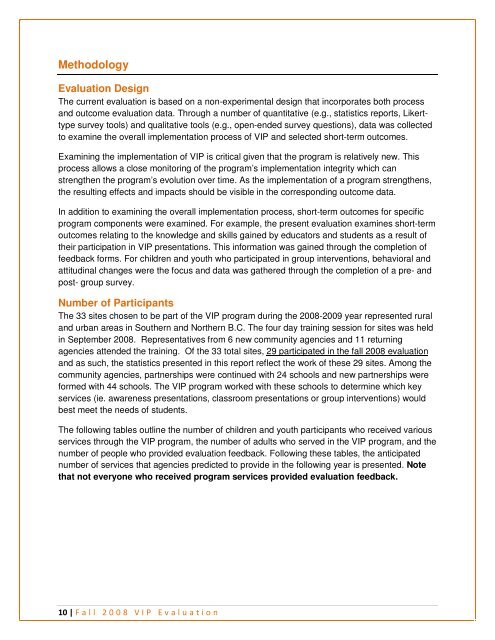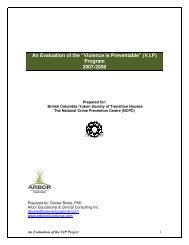An Evaluation of the Violence is Preventable (VIP) Program
An Evaluation of the Violence is Preventable (VIP) Program
An Evaluation of the Violence is Preventable (VIP) Program
You also want an ePaper? Increase the reach of your titles
YUMPU automatically turns print PDFs into web optimized ePapers that Google loves.
Methodology<br />
<strong>Evaluation</strong> Design<br />
The current evaluation <strong>is</strong> based on a non-experimental design that incorporates both process<br />
and outcome evaluation data. Through a number <strong>of</strong> quantitative (e.g., stat<strong>is</strong>tics reports, Likerttype<br />
survey tools) and qualitative tools (e.g., open-ended survey questions), data was collected<br />
to examine <strong>the</strong> overall implementation process <strong>of</strong> <strong>VIP</strong> and selected short-term outcomes.<br />
Examining <strong>the</strong> implementation <strong>of</strong> <strong>VIP</strong> <strong>is</strong> critical given that <strong>the</strong> program <strong>is</strong> relatively new. Th<strong>is</strong><br />
process allows a close monitoring <strong>of</strong> <strong>the</strong> program’s implementation integrity which can<br />
streng<strong>the</strong>n <strong>the</strong> program’s evolution over time. As <strong>the</strong> implementation <strong>of</strong> a program streng<strong>the</strong>ns,<br />
<strong>the</strong> resulting effects and impacts should be v<strong>is</strong>ible in <strong>the</strong> corresponding outcome data.<br />
In addition to examining <strong>the</strong> overall implementation process, short-term outcomes for specific<br />
program components were examined. For example, <strong>the</strong> present evaluation examines short-term<br />
outcomes relating to <strong>the</strong> knowledge and skills gained by educators and students as a result <strong>of</strong><br />
<strong>the</strong>ir participation in <strong>VIP</strong> presentations. Th<strong>is</strong> information was gained through <strong>the</strong> completion <strong>of</strong><br />
feedback forms. For children and youth who participated in group interventions, behavioral and<br />
attitudinal changes were <strong>the</strong> focus and data was ga<strong>the</strong>red through <strong>the</strong> completion <strong>of</strong> a pre- and<br />
post- group survey.<br />
Number <strong>of</strong> Participants<br />
The 33 sites chosen to be part <strong>of</strong> <strong>the</strong> <strong>VIP</strong> program during <strong>the</strong> 2008-2009 year represented rural<br />
and urban areas in Sou<strong>the</strong>rn and Nor<strong>the</strong>rn B.C. The four day training session for sites was held<br />
in September 2008. Representatives from 6 new community agencies and 11 returning<br />
agencies attended <strong>the</strong> training. Of <strong>the</strong> 33 total sites, 29 participated in <strong>the</strong> fall 2008 evaluation<br />
and as such, <strong>the</strong> stat<strong>is</strong>tics presented in th<strong>is</strong> report reflect <strong>the</strong> work <strong>of</strong> <strong>the</strong>se 29 sites. Among <strong>the</strong><br />
community agencies, partnerships were continued with 24 schools and new partnerships were<br />
formed with 44 schools. The <strong>VIP</strong> program worked with <strong>the</strong>se schools to determine which key<br />
services (ie. awareness presentations, classroom presentations or group interventions) would<br />
best meet <strong>the</strong> needs <strong>of</strong> students.<br />
The following tables outline <strong>the</strong> number <strong>of</strong> children and youth participants who received various<br />
services through <strong>the</strong> <strong>VIP</strong> program, <strong>the</strong> number <strong>of</strong> adults who served in <strong>the</strong> <strong>VIP</strong> program, and <strong>the</strong><br />
number <strong>of</strong> people who provided evaluation feedback. Following <strong>the</strong>se tables, <strong>the</strong> anticipated<br />
number <strong>of</strong> services that agencies predicted to provide in <strong>the</strong> following year <strong>is</strong> presented. Note<br />
that not everyone who received program services provided evaluation feedback.<br />
10 | F a l l 2 0 0 8 V I P E v a l u a t i o n






